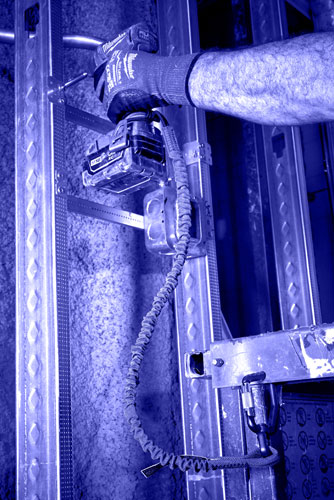Fall 2020
Tool Tethering
According to the Bureau of Labor Statistics, a number of accidents occur in the workplace each year due to workers being struck-by falling objects. An emerging category of protective equipment is becoming more widely available offering a proactive way to directly reduce stuck-by accidents involving dropped tools. Tool tethers (“tethers”), also referred to as “lanyards”, help reduce the risks associated with dropping tools being used at height. Tethers are designed to connect the tool to a stable structure. There are two general categories of tethers: rigid (also called “fixed length”); and elastic (also called “extendable”). When a tool is connected to an elastic tether, the tether is engineered to slow a dropped tool to a stop, much like a shock absorber, preventing a free-fall to the ground or floor below. By reducing the forces associated with a fall from height, tethers can help reduce or prevent damage to the tool and/or structure while also allowing the tool to be easily recovered by the user.
Recently, the International Safety Equipment Association (ISEA) worked with industry stakeholders to develop and publish a new voluntary standard (ISEA 121-2018) which establishes minimum requirements for the design, labelling, testing and performance of tool tethers and their associated attachment equipment. The standard addresses four components - those being the anchor attachments (how the tether attaches to the structure), tool attachments (how the tether attaches to a tool), tool tethers, and containers (used to raise small equipment or supplies to height). Note that other established tethers and drop prevention programs may have different requirements.
When incorporating a tethering program, selecting an ISEA 121-2018 compliant tether and using it in accordance with the tether manufacturer’s instructions reduces the risks associated with working at height. Equally important is the need to ensure your tool is designed to be connected to a tether. Not all tools, or locations on a tool are suitable for tether connection and only those recommended by the tool manufacturer should be used. Here are a few tips to help ensure a tether is used to safely secure a tool.
Do’s and Don’ts
Do:
- Make sure all components (anchor attachment, tether, and tool attachment), are rated for the maximum weight of the tool. This includes the tool itself, all inserts or accessories, and, for cordless tools, the weight of the heaviest battery.
- Read, understand, and follow all instructions before use. Pay particular attention to any limitations listed for any component (e.g., tool attachments which may only be used with specific tethers).
- Inspect the tether before each use.
- Secure the anchor attachment only to structures suitable to withstand arresting forces
- Ensure your tool is designed to be connected to a tether, and if so, which locations are suitable for tether attachment.
- Ensure the tether does not interfere with the operation of the tool, including guards, locks, and switches.
- Ensure removable parts (accessories, inserts, batteries, etc.) are securely attached to the tool.
- Use the shortest tether suitable for your task – longer tethers allow the tool to drop further and create more stress on the system when a drop occurs.
Do Not:
- Do not use for personal fall protection.
- Do not exceed maximum capacity of the tether or the tool attachment.
- Do not alter tethers or use in a manner other than as instructed.
- Do not use tethers near sharp or rough edges that could cut or fray.
- Do not secure tethers to moveable objects, such as ladders or toolboxes.
- Do not secure tethers to yourself for tools over 5 lbs.
- Do not secure tethers on removable parts such as batteries, side handles, guards, or accessories.
- Do not use near moving parts or machinery.
- Do not intentionally extend elastic tethers – they are intended ONLY for accidental drops.
THIS DOCUMENT IS PROVIDED BY POWER TOOL INSTITUTE (“PTI”) FOR INFORMATIONAL PURPOSES ONLY. ANY INACCURACY OR OMISSION IS NOT THE RESPONSIBILITY OF PTI. PTI DOES NOT MAKE ANY REPRESENTATIONS OR WARRANTIES WITH RESPECT TO THIS DOCUMENT OR ITS CONTENTS. PTI HEREBY DISCLAIMS ALL WARRANTIES OF ANY NATURE, EXPRESS, IMPLIED OR OTHERWISE, OR ARISING FROM TRADE OR CUSTOM, INCLUDING, WITHOUT LIMITATION, ANY IMPLIED WARRANTIES OF MERCHANTABILITY, NONINFRINGEMENT, QUALITY, TITLE, FITNESS FOR A PARTICULAR PURPOSE, COMPLETENESS OR ACCURACY. TO THE FULLEST EXTENT PERMITTED BY APPLICABLE LAWS, PTI SHALL NOT BE LIABLE FOR ANY LOSSES, EXPENSES OR DAMAGES OF ANY NATURE, INCLUDING, WITHOUT LIMITATION, SPECIAL, INCIDENTAL, PUNITIVE, DIRECT, INDIRECT OR CONSEQUENTIAL DAMAGES OR LOST INCOME OR PROFITS, RESULTING FROM OR ARISING OUT OF A COMPANY’S OR INDIVIDUAL’S USE OF THIS DOCUMENT, WHETHER ARISING IN TORT, CONTRACT, STATUTE, OR OTHERWISE, EVEN IF ADVISED OF THE POSSIBILITY OF SUCH DAMAGES.

